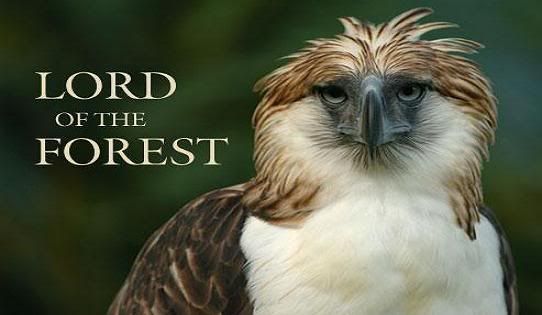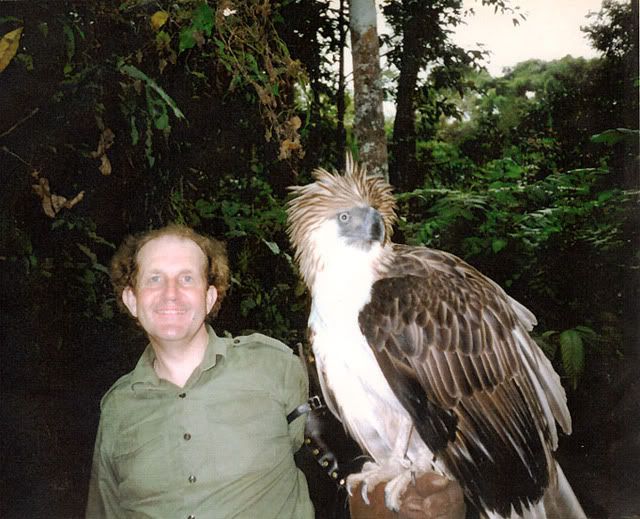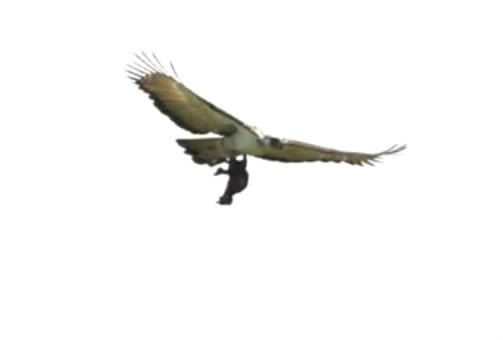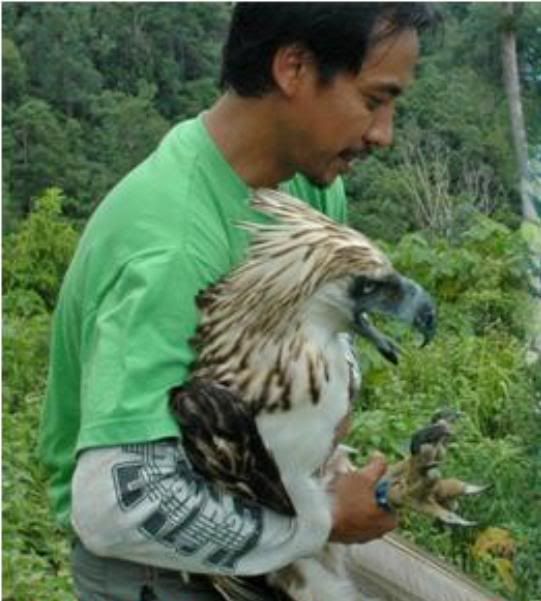The Philippine Eagle (Pithecophaga jefferyi)
 |
Description
What better way to properly start
off this feature then by introducing my overall favorite animal.
The Philippine eagle is also known as the monkey-eating eagle; it is the worlds largest eagle measuring at 86 - 102cm in length with a 2m wingspan. It weighs between 4.7 - 8.0 kilograms, meaning that although it is the largest in terms of length it is not in regard to weight and bulk with is being surpassed only by the Steller's sea eagle and Harpy eagle. Although it is the largest and one of the most powerful raptors it is also listed as one of the most endangered. IUCN classifies the species as one of the most critically endangered vertebrates on the planet.
The Philippine eagle is also known as the monkey-eating eagle; it is the worlds largest eagle measuring at 86 - 102cm in length with a 2m wingspan. It weighs between 4.7 - 8.0 kilograms, meaning that although it is the largest in terms of length it is not in regard to weight and bulk with is being surpassed only by the Steller's sea eagle and Harpy eagle. Although it is the largest and one of the most powerful raptors it is also listed as one of the most endangered. IUCN classifies the species as one of the most critically endangered vertebrates on the planet.
 |
| IUCN classification of Philippine Eagle |
The Philippine eagle's nape is adorned with long, brown feathers that form a shaggy crest. These feathers give it an appearance of possessing a lion's mane, possibly explaining why it is often called "habiron" meaning "king bird". It has a dark face and a creamy brown nape and crown. The top of the bird is dark brown whilst its underside and underwings are white . It has large, heavy yellow legs each containing large, dark powerful talons, the deep beak of the Philippine eagle is a bluish grey, similar to its eye colour. The plumage of the juveniles are similar to the adults except their underparts have pale fringes.
 |
| Klaus Nigge - National Geographic (2008) |
 |
| Philippine eagle foundation |

Size comparison against a human

Biology
The Philippine eagle can live for up to 60 years. They feed primarily on flying lemurs (90% of its diet), palm civets and monkeys, other prey items include rats, bats, snakes, flying squirrels and birds. They utilize 2 main hunting strategies. The first is still-hunting where the bird watches for its prey activity whilst sitting motionlessly on a branch near the canopy. The second strategy is perch-hunting, the eagle will gradually work its way down from the canopy by gliding from perch to perch looking for food. if unsuccessful the fly or circle back up to the top of the trees and work them again.
 |
| Catching a monkey |
 |
| Philippine eagle with prey |
It has also been found that pairs of Philippine eagles will hunt troops of monkeys (typically the local macaque species) cooperatively. One bird perches near the troop acting as a decoy to distract them which allows the partner to swoop in from the rear and seize a monkey through the element of surprise. This method is particularly desired when hunting monkeys as the macaques are around the same size as the eagle.
The Philippine eagle is monogamous and they build their nests high up in the canopy at around 30m. The territory of a single pair can span 133 sq Km (51 sq m). They lay a single egg between October and December. Females sexually mature at 5 and the males at 7. Nest building signals the beginning of courtship. Aerial displays play a large role in their courtship, they include paired soaring over nesting territory, the male chasing the female in a diagonal dive, and mutual talon presentation. The single egg is incubated for 62 days with both sexes participating in incubation, both sexes also help feed the eaglet. The eaglet itself fledges after 4 or 5 months and both parents take care of the chick for a total of 20 months.
Range and habitat
This eagle is endemic to the Philippines, and can be found on selective parts of the islands of Luzon, Samar, Leyte and Mindanao. It was once widespread but today there is only thought to be less than 250 mature birds. Populations are very small and as of 2013 the Philippine eagles numbers were still thought to be decreasing in the wild. It inhabits remnant patches of primary dipterocarp forest.
 |
| The distribution of the Philippine eagle in blue-green |
Threats and conservation
The decline of the Philippine eagle has been a direct result of habitat destruction and fragmentation, through commercial timber extraction and shifting cultivation. Forest continues to be lost rapidly, it is believed that as little as 9220 sq km may remain within the eagles range. In the short term, hunting has been the most significant threat, juveniles are easy to shoot and trap and adult birds may also accidentally get caught in traps, intended for pigs and deer, whilst hunting on the forest floor. The killing of a Philippine eagle is punishable by 12 years in jail and heavy fines.
 |
| Philippine eagle being caught |
The falling numbers of the eagle was first bought to international attention in 1965 by the Filipino ornithologist Dioscoro S. Rabor and the director of the Parks & Wildlife Office, Jesus A. Alverez. The Monkey-eating Eagle Conservation Program was started in 1969. However, it was not until 1992 the first chicks were born in captivity, through artificial insemination. The first natural birth in captivity came in 1999. Successive releases in the early 21st century were unsuccessful with the bird being killed. Its numbers have continued to dwindle since then. The Philippine Eagle foundation of Davao City, Mindanao is the main organisation dedicated to the protection and conservation of the eagle and its habitat. They have successfully bred Philippine eagles in captivity for the last decade and conducted the first experimental release to the wild. The centre currently houses 35 birds (18 of which are captive bred). Ongoing research on behaviour, ecology and population dynamics is also underway including the setting up of protected lands specifically for this species. The Philippine eagle has also become a flagship species of the Philippines and was declared the national bird of the Philippines by president Fidel V. Ramos in 1995.
In all seriousness this is one of the most marvelous creatures left on the planet. if habitat destruction continues it is unlikely that this species will ever recover. Below I'll post the link to the Philippine Eagle Foundation (PEF) website so you can all take a look at their work. This is a bird I would love to go out and work with in the future.
Website: http://www.philippineeagle.org/index?pageval=thepef
Facebook: https://www.facebook.com/pages/Philippine-Eagle-Foundation-Official/149246185148978
Again none of the above images belong to me and all rights reserved to the original photographer. I do try and find the original source for as many of the photos as possible so I can give credit as I use them, but that's easier said then done.
Birdman.



No comments:
Post a Comment